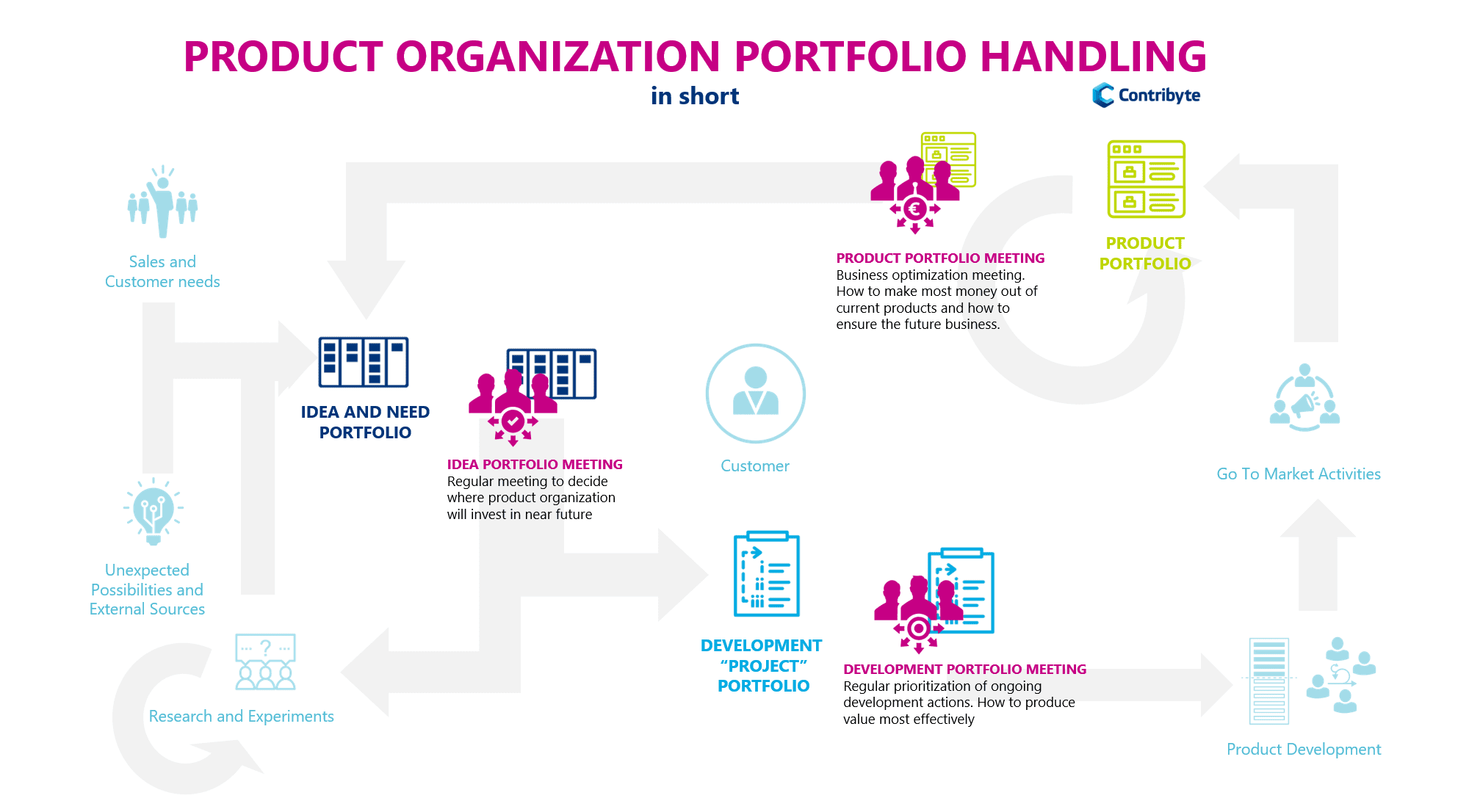The Management of Idea, Development and Product Portfolios Is the Most Effective Part of Decision Making in Business
The Management of Idea, Development and Product Portfolios Is the Most Effective Part of Decision Making in Business
The term “portfolio management” is one of those organizational words which have been given multiple meanings.
The term “portfolio management” is one of those organizational words which have been given multiple meanings. I must have participated in hundreds of discussions in which the term has been used to describe different things. Product and service organizations always have at least three different portfolios, although few organizations actually manage them separately. However, as the portfolios have very different purposes, they should be managed in different ways using different forums.
Many Types of Portfolio Management
All organizations have several portfolios. Different decision-making processes are needed in the different stages of business and lifecycles of products and features. Every organization has at least three types of portfolios: 1) idea and need portfolios, 2) development portfolios, and 3) product portfolios. Product and service organizations always have these three types of portfolios – whether they want that or not. Whether these portfolios should be managed as separate portfolios is a subject that needs discussion. The steering systems of the best organizations have been built around their portfolios, which means that these organizations are able to maximize the advantages offered by their products, services, and product development.

Idea and Need Portfolio – Investing in the Future
 Many organizations use the term “portfolio management” when they actually refer to idea and need portfolio management. For example, Portfolio Kanban is a tool for this type of portfolio management. One reason for this is probably that this type is the only portfolio used in the popular SAFe model.
Many organizations use the term “portfolio management” when they actually refer to idea and need portfolio management. For example, Portfolio Kanban is a tool for this type of portfolio management. One reason for this is probably that this type is the only portfolio used in the popular SAFe model.
The central purpose of idea and need portfolio management is to make investment decisions concerning the priorities of product development, or, in other words, to improve the organization’s future competitivity. Business cases and related tools, such as the Lean Business Case and the Business Model Canvas, can be used to support decision making. However, some decisions may require testing and research in addition to business cases. These types of decisions require a different process than those that can be directly productized.
The inputs for the idea and need portfolio can come from any source. We have divided these sources into four categories: improvement of existing products, sales and customer needs, research and tests, and unusual sources. The improvement of existing products can mean either small improvements or larger processes where the product is replaced with a new one. Sales and customer needs can involve responding to the requests of customers or understanding the market on a broader scale. Research and tests can create possibilities through tests that have been authorized by the organization. The unusual and outside sources include new market opportunities outside the organization’s current sector.
Development Portfolio – Prioritizing Product Development Tasks
 The development portfolio refers to the new products or features that the product organization is currently working on. Such terms as the product development organization’s backlog or project portfolio can also be used. This does not mean that the organization only focuses on completing projects according to the waterfall model. Development portfolio management is the foundation of the agile development of the organization. All features that are worked on or waiting to be released belong to development portfolio management.
The development portfolio refers to the new products or features that the product organization is currently working on. Such terms as the product development organization’s backlog or project portfolio can also be used. This does not mean that the organization only focuses on completing projects according to the waterfall model. Development portfolio management is the foundation of the agile development of the organization. All features that are worked on or waiting to be released belong to development portfolio management.
Development portfolio management is the most essential tool to ensure efficient product development. In the product organization, nothing can be as useless as creating features that are too complex or unwanted. Development portfolio management does not have to be centralized: it can be led by teams, product owners, or product managers. The most essential thing is to ensure that this work is seen and let people know about the decisions that have been made.
Development portfolio management is often poorly handled in organizations. People tend to think that starting a project means that it is worth following through. Continuous learning and prioritization are the basic concepts behind a winning organization. Creating new features is a continuous learning process. The best organizations continuously test the features with their clients, and even the mediocre ones can at least learn something new about technology during the development process. Learning serves no purpose, however, if it is does not lead to decisions and changes. Prioritization is a must. You can be 100% certain that not all planned features or parts of these features are worth completing. This is the most effortless way to enhance the product organization’s productivity.
Product Portfolio – Identify the Successes, Discard the Unprofitable
 The product portfolio is the source of the company’s cash flows. The product portfolio includes the released products and features which create revenue for the organization. Product portfolio management is the most essential tool to ensure the company’s success in the near future, i.e., the following 0–24 months. The product portfolio might have sources for ideas that can be used later on as well, but these new ideas should be first analyzed and prioritized in the idea and need portfolio.
The product portfolio is the source of the company’s cash flows. The product portfolio includes the released products and features which create revenue for the organization. Product portfolio management is the most essential tool to ensure the company’s success in the near future, i.e., the following 0–24 months. The product portfolio might have sources for ideas that can be used later on as well, but these new ideas should be first analyzed and prioritized in the idea and need portfolio.
One of the best-known product and service portfolio management tools is the growth-share matrix introduced a while back by the Boston Consulting Group. In this chart, products are put into four categories according to their market shares and growth rates: cash cows, stars, question marks, and dogs. These categories help the organization to decide whether to invest in or kill the product. It pays to remember that the further investments do not necessarily include product development, as they can be, for example, investments in marketing or sales. For many, killing a product is the hardest part. Few organizations are able to say “no” to the client, meaning that some products are kept alive artificially for too long.
Of course, the BCG growth matrix is not the only tool that can and should be used in product portfolio management. For example, digital services might require a very different measurement system compared to traditional physical products. Each organization should find their own measurement systems for their products and services to ensure that their product portfolio is efficient enough for the strategy and market.
Three Portfolios – the Three Most Important Tools Along with Strategy
Organizations that do not manage three separate portfolios – the idea and need portfolio, development portfolio, and product portfolio – are not in charge of their organization’s future. Some organizations should divide their portfolios into smaller parts: for example, the development portfolio can be managed by product areas. For the organization to be a winning one, it should at least manage these portfolios using different methods and forums. This is due to the fact that the objectives as well as the decision-making cycles and models of these portfolios are very different.
The management of idea, development and product portfolios is the most effective part of decision making in business.
Principle of a Winning Organization – Contribyte

Henri Hämäläinen
CEO, Consultant
Henri is the CEO of Contribyte and a Coach of Organizations. Over the past 15 years, he has been working as a coach for dozens of organizations. Henri insists that even as the CEO, he would have time to coach and train organizations. Henri's free time is spent on a variety of sporting activities with friends and family alike. Outdoor sports such as cycling, running, orienteering, skiing or dog walking are close to the heart.




